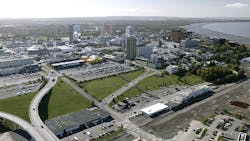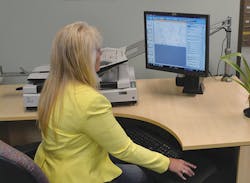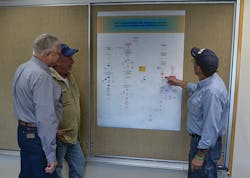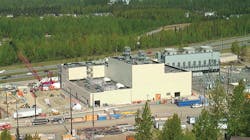Alaskans enjoy a long history of striking it rich. Most recently, when Anchorage Municipal Light & Power (ML&P) decided to investigate electronic records management technology, it hit paperless pay dirt.
It was not any single pressing need that prompted the utility’s initial interest in the technology. Rather, it was the growing realization that turning paper documents into electronic images would make working with them much easier. How much easier was the first of many discoveries that ML&P is still making as the system grows well beyond a very modest but carefully thought-out pilot project, which started with the utility’s as-builts.
Paper, Paper, Paper
These vital documents are distilled from the various sources of paperwork generated by the utility’s maintenance and capital improvement operations. Involving input from many divisions and personnel, utility as-builts can be complex — even more so when the utility dates back to 1932, then serving a population of 3,000 that has grown to more than 300,000 and has absorbed several smaller utilities over those years along with their as-built records. Two other electric utilities now serve the expanded area of the municipality of Anchorage. ML&P generates, transmits and delivers 840,000 MWh of power annually to more than 30,000 urban customers through a network of power lines, transformers and relays in its 20-sq-mile (52-sq-km) service area. In doing so, it produces approximately 3,000 as-builts/work orders per year.
While virtually every operation in the utility is clogged with paper, as-builts are the crucial conduit through which completed work orders get translated into the engineering division’s final grid maps and the finance division’s asset inventory — records ML&P heavily relies on for day-to-day operations. At any given time, numerous divisions involving dozens of ML&P staff will be involved in executing any one work order.
Under the utility’s former paper-based system, recording all that effort and input into finished as-builts involved ensuring all related records were complete, accurate and up to date. Doing so involved a time-consuming wash of documents among divisions and the staff affected, leaving little doubt that starting ML&P’s paperless project with the as-builts provided the biggest bang for the buck. It was also a logical starting point because the engineering division was already working with electronic records, grid maps maintained in a geographic information system (GIS) and drawings in an AutoCAD system.
Workflow Management
Perhaps most important, the grid maps are the primary reference for all future work orders, and their accuracy is key to keeping field workers safe. These folks need to know exactly what they are touching and, unless the engineers have accurate, up-to-date as-builts, it can make the grid maps of the electrical facilities being worked on less reliable. To fulfill these needs and plans, ML&P purchased a Laserfiche enterprise content management system to automate how information in finished work order records is routed into the as-built and then routed to the engineering and finance divisions.
The system’s software enables the creation of workflows that instantly distribute electronic documents from decision-maker to decision-maker, rather than having those same skilled staff spend time exchanging paper records by hand. However, putting these systems in place was, at first, well beyond the expertise of ML&P’s engineering and information technology (IT) divisions, so the utility turned to the regional Laserfiche reseller, eDocs Alaska.
The Anchorage-based company has built similar workflows for numerous large-scale Alaska organizations and agencies, such as Pebble Mines and the Chugach Electric Association. That expertise guided ML&P’s engineering and IT staff through creating the workflows that now ensure field workers have the most up-to-date information before heading out in the morning. It also means the finance division has the latest, most accurate record of the utility’s asset inventory.
These workflows now allow staff in both divisions to know exactly where to find the records they depend on. The software also allows for instant access to any one of those records from among the tens of thousands that have been added to ML&P’s fast-growing electronic records repository. ML&P engineers are no longer digging through filing cabinets, so they have more time to do what they are paid to do: design infrastructure.
The enthusiastic reception by all staff involved in automating the as-builts made it clear the project needed to expand to include work orders — the complex, sometimes-convoluted process of documenting how things actually get built, repaired and maintained at ML&P. On top of the challenges any utility faces in accurately documenting execution of work orders, Alaska’s frozen winters often mean ML&P must rely on temporary installations, which must be finished when the ground thaws. As a result, the utility can have many more work orders to keep track of at any given time than a comparable utility in a more forgiving climate.
Finding a way to keep all those work orders straight while also automating the means of doing so was a considerably greater undertaking, and the utility needed to expand access of the Laserfiche system to 125 of ML&P’s 210 employees. To justify the cost of the added licenses and technical support, ML&P started working on the numbers to determine its return on investment (ROI) up to that point in the paperless project, and then take those numbers to the city council along with a change-order request.
Measuring Efficiency
Measuring efficiency accrued in so many different areas of operations can be difficult to tally in dollars and cents. The engineers said they are spending 75% less time looking for the information needed to put together their projects. Finance was reporting the same sort of time savings in keeping its asset inventory current. Ultimately, ML&P calculated the time saved in six months would equal the cost of the software, licenses and training involved in putting the new system in place.
Concerned such a figure might be greeted with skepticism from a city council that took two years to approve the initial project, ML&P decided to round out the ROI to less than a year. It turned out that it did not matter, as the clear success of the as-built phase of the project — and the fact IT’s newfound familiarity with the technology would significantly speed any future expansion — was enough to gain city council approval quickly for the second phase of the project. ML&P could now make its work order process paperless and build workflows to automate as much of it as possible.
Key to this plan was improving the research capabilities at ML&P so all divisions involved in executing work orders would no longer be spending hours each day locating documents, as engineering and finance had done previously. Only in this second phase, many more divisions were involved, and each division had its own way of doing things.
Under the paper-based process, if people lost needed work-order documentation, they would call engineering for help or just submit what they had. Or, they would make their own copies, resulting in multiple versions of the same work order being used at the same time. Those various work orders would then need to be reconciled into a single as-built, leading to a lot of double-checking and uncertainty about the end product. Resolving those frustrations and ensuring the same work order for each project was used by every division were also priorities for the second phase of the electronic records project.
One workflow was designed for automating the dissemination of each new work order to all the divisions involved in its execution, so each division would be working from the same starting point. Another workflow automated the collection of the records those divisions create in completing the work order.
The second phase of the project was a huge undertaking that took more than a year to design, develop and test. It went live in January 2015 after extensive training. While it is too early to calculate ROI, it is clear the new workflows are going to meet the high bar set in the as-built phase of the project.
Mindset Shift
Another ROI that will be much more difficult to calculate is the shift in mindset at ML&P. Seeing the paperless project work so well, despite being a radical overhaul of how employees do their jobs, has opened the door to getting the entire utility to leave its paper-bound ways behind.
This was no easy transition. A lot of people had to be convinced there would be no going back to the paper-based systems that sustained operations since the origins of the utility. Staff needed to be enthusiastic. They needed to put on their thinking caps and help to plan the workflows being built. The planning process was foundational to building the workflows and led to another of the big discoveries made: There were many ways to do the same job, some a whole lot easier than others.
Seasoned ML&P staff had the boots-on-the-ground knowledge of what these systems must do, while eDocs Alaska engineers had the technological experience to help find the most efficient ways to get that done. The end result was the simplification of a number of utility operations that had remained relatively unchanged for decades. Staff across the utilitity are pleased with the way Laserfiche implementation has simplified their work. This effort has also set a standard for the entire municipality of Anchorage to achieve.
Looking for Less Paper
With everything up and running, ML&P is now looking at where next to take utility operations paperless. Many of the field operations still require paper, so expanding the use of mobile devices is a likely next step for the work order and as-built processes. Generation, human resources, accounts payable and archiving are also being considered for electronic workflows. Wherever Laserfiche is put to work next, its role in revolutionizing the work order and as-built process makes clear paperless is the only way to go in records management. For a utility that has relied on paper for the past century, this is perhaps the biggest discovery of all.
Everett Clary ([email protected]) has worked in the electric utility and water/wastewater business for 16 years. At Anchorage Municipal Light & Power, Clary managed the Laserfiche implementation for the engineering as-built and shop order workflows. Currently, Clary supervises ML&P’s engineering survey crew, locates section and drafting/CAD/GIS section, and is incorporating AutoCAD and GIS into the existing engineering and information technology systems.
Patty Caress ([email protected]) is the utility technical assistant for the engineering division at Anchorage Municipal Light & Power. She served as subject-matter expert for the implementation of Laserfiche for the engineering as-built and shop order workflows, coordinated end-user interviews and data collection for design of the workflow diagrams, coordinated with the Laserfiche contractor and ML&P systems for workflow development, prepared training documentation, and conducted extensive workflow testing and end-user training along with ML&P systems personnel.



